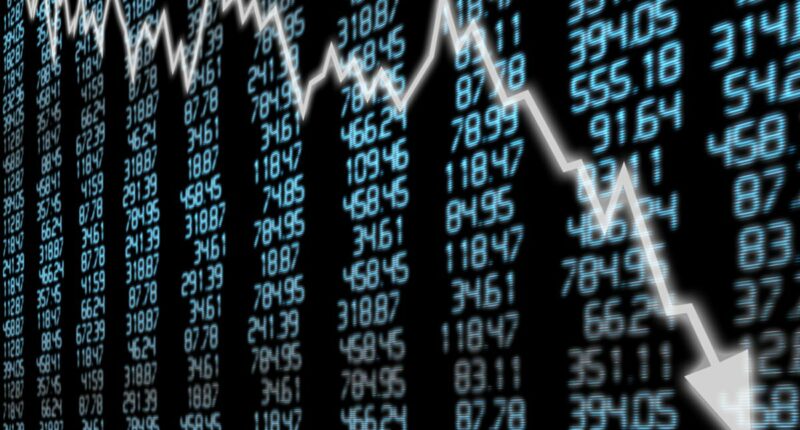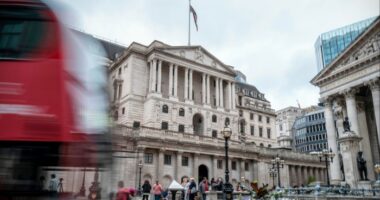Share this @internewscast.com
The financial landscape has seen its fair share of turbulence, from the dotcom bubble to market downturns, and experts are vocalizing concerns about potential economic challenges on the horizon.
Last Friday, the stock markets displayed signs of anxiety typical of the latter stages of a bull market, as the S&P 500 neared the third anniversary of its October 2022 low point.
This milestone was marked by an impressive near-90 percent gain over three years, yet it quickly turned sour as the US index suffered a significant 2.7 percent drop—its most severe single-day decline since April.
Tom Stephenson, an investment director at Fidelity International, noted, “Friday’s market fluctuation serves as a reminder that stock prices can become quite unpredictable in the final stages of a bull market.”
He drew parallels to the end of the dotcom boom 25 years ago, when price swings were similarly prominent.
On a brighter note, Sarah Coles from Hargreaves Lansdown reassures that forecasters aren’t predicting an immediate economic crisis.
But for those who have significant sums invested, for example in a pension or stocks and shares Isa, it is worth taking stock of their finances and how much money they have set aside for a rainy day.

Storm clouds brewing? Financial experts say signs point to a possible stock market downturn
Why do you need cash when markets are down?
Cash is the backbone of an emergency fund. Having a buffer in case of an unexpected expense is always important, and even more so in turbulent times.
Sarah Coles, head of personal finance at stockbroker Hargreaves Lansdown says: ‘Emergency savings are an essential part of preparing for disaster.
‘Most of the heavy lifting in your financial safety net will be done by your emergency savings.’
However, Coles adds that, while there are signs of weakness in the economy, ‘we don’t need to doom-prep for an imminent financial disaster.’
‘Doom-prepping’ describes the act of preparing for an end-of-the-world doomsday scenario, where people stockpile food and water in self-fashioned underground bunkers to weather out the end of the world.
While we don’t necessarily need to prepare for the worst where the markets are concerned, having a cash buffer can make people feel more secure – especially if they rely on income from investments, for example within a pension.
How much cash do YOU need?
As a rule of thumb, experts recommend having an emergency fund which covers three to six months’ worth of essential spending, plus money for any planned expenses over the next five years.
But for those in their sixties and above, this grows to between one and three years’ worth of essential costs.
This is because savers who reach the age of retirement and stop working are usually on a lower, fixed income.
‘The idea is that this is enough to cope with a run of expenses out of the blue, or to cover your costs if you lost earnings for a period,’ says Coles. ‘You don’t need to pay for everything – just keep things ticking over until life improves.’
What you class as ‘the essentials’ varies depending on how much you earn, however.
A household with an annual income of less than £15,000 spends £774 on essentials each month according to Hargreaves Lansdown. This means that three to six months of essentials would be between £2,322 and £4,622.
But for a household with an annual income of more than £150,000, which spends £6,848 on essentials each month, three to six months of essential expenses is between £20,544 to £41,000.
One to three years’ worth of essential spending could amount to £82,176 for one year and £246,528 for three years for this group.
The median household in Hargreaves Lansdown’s analysis with an annual income of £70,000 to £100,000 spends £3,330 on essentials each month.
To cover the recommended three to six months’ worth of emergency savings they would need between £9,990 and £19,980 tucked away.
The extended one to three years’ worth would require between £39,960 and £119,880.
| Annual household income | Monthly spending on essentials | 3 months’ worth | 6 months’ worth | 1 year’s worth | 3 years’ worth |
|---|---|---|---|---|---|
| Less than £15,000 | £774 | £2,322 | £4,622 | £9,288 | £27,864 |
| £15,000 to £30,000 | £1,431 | £4,293 | £8,586 | £17,172 | £51,516 |
| £30,000 to £50,000 | £ 2,091 | £6,273 | £12,546 | £25,092 | £75,276 |
| £50,000 to £70,000 | £2,696 | £8,088 | £16,176 | £32,352 | £97,056 |
| £70,000 to £100,000 | £3,330 | £9,990 | £19,980 | £39,960 | £119,880 |
| £100,000 to £130,000 | £4,146 | £12,438 | £24,876 | £49,752 | £149,256 |
| £130,000 to £150,000 | £5,100 | £15,300 | £30,600 | £61,200 | £183,600 |
| more than £150,000 | £6,848 | £20,544 | £41,088 | £82,176 | £246,528 |
| Source: Hargreaves Lansdown | |||||
To work out how much you’ll need in emergency savings, the first step is to consider how many months’ worth of essentials you need to cover.
Where you fall on the spectrum of three to six months or one to three years will depend on your circumstances.
If there are a number of people relying on your income, and you have had health problems in the past or your income is insecure, you might want to think about holding more cash.
You should also consider how many earners there are in your family and any insurance cover you have in place.
The next step is going through your spending and isolating the things you really can’t live without, and what they cost. This will reveal what you should be aiming to have in cash.
To start building an emergency savings pot, you can set up a monthly direct debit into a savings account, saving little and often.
Where should you save your emergency fund?
The best place for your emergency fund is an easy-access savings account or cash Isa, as your money will be instantly accessible when you need it.
You’ll want to get the best interest rate possible to boost your rainy day pot from the get-go. The top accounts currently pay between 4 and 5 per cent.
Some of these accounts have restrictions, for example only allowing a limited number of withdrawals per year, or requiring you to keep a certain amount in the account, so do check the small print. If you don’t meet these criteria, the interest rate can fall.
It’s worth checking out smaller banks and online savings apps, where you can usually find higher rates than the high street banks.
You can see the best easy-access savings accounts and cash Isas on This is Money’s best-buy savings rate tables.
SAVE MONEY, MAKE MONEY
Sipp cashback

Sipp cashback
£200 when you deposit or transfer £15,000
4.51% cash Isa
4.51% cash Isa
Trading 212: 0.66% fixed 12-month bonus
£20 off motoring

£20 off motoring
This is Money Motoring Club voucher
Free shares bundle

Free shares bundle
Get free UK shares worth up to £200
4.37% Isa with bonus

4.37% Isa with bonus
Now with no penalty for withdrawals
Affiliate links: If you take out a product This is Money may earn a commission. These deals are chosen by our editorial team, as we think they are worth highlighting. This does not affect our editorial independence. Terms and conditions apply on all offers.











